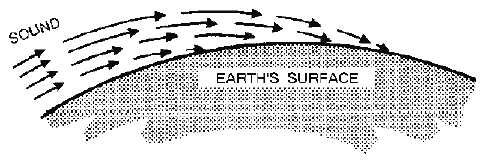1-24
the surface of the earth has a greater velocity than that near the surface because friction retards the lower
layers (see figure 1-16). The velocity of the wind is added to the velocity of the sound through the air. The
result is that the upper portion of the sound wave moves faster than the lower portion and causes a gradual
change in the direction of travel of the wave. Refraction causes sound to travel farther with the wind than
against it.
Figure 1-16.—Refraction of sound.
Reverberation
In empty rooms or other confined spaces, sound may be reflected several times to cause what is
known as reverberation. REVERBERATION is the multiple reflections of sound waves. Reverberations
seem to prolong the time during which a sound is heard. Examples of this often occur in nature. For
instance, the discharge of lightning causes a sharp, quick sound. By the time this sound has reached the
ears of a distant observer, it is usually drawn out into a prolonged roar by reverberations that we call
thunder. A similar case often arises with underwater sound equipment. Reverberations from nearby points
may continue for such a long time that they interfere with the returning echoes from targets.
Interference
Any disturbance, man-made or natural, that causes an undesirable response or the degradation of a
wave is referred to as INTERFERENCE.
Two sound waves moving simultaneously through the same medium will advance independently,
each producing a disturbance as if the other were not present. If the two waves have the same
frequency—in phase with each other—and are moving in the same direction, they are additive and are
said to interfere constructively. If the two waves have the same frequency and are moving in the same
direction, but out of phase with each other, they are subtractive and are said to interfere destructively. If
these two subtractive waves have equal amplitudes, the waves cancel each other. This addition or
subtraction of waves is often called interference.
Resonance
At some time during your life you probably observed someone putting his or her head into an empty
barrel or other cavity and making noises varying in pitch. When that person's voice reached a certain
pitch, the tone produced seemed much louder than the others. The reason for this phenomenon is that at
that a certain pitch the frequency of vibrations of the voice matched the resonant (or natural) frequency of
the cavity. The resonant frequency of a cavity is the frequency at which the cavity body will begin to
vibrate and create sound waves. When the resonant frequency of the cavity was reached, the sound of the
voice was reinforced by the sound waves created by the cavity, resulting in a louder tone.



